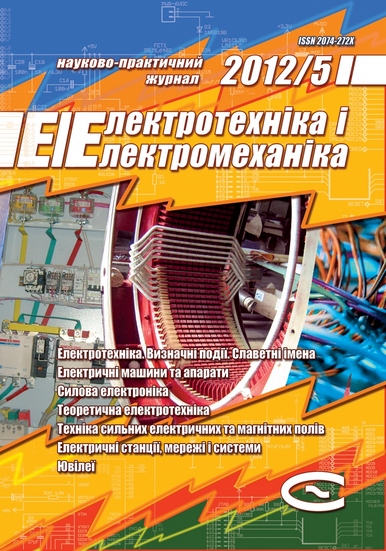Additional power loss in a frequency-controlled induction motor due to voltage higher harmonics
DOI:
https://doi.org/10.20998/2074-272X.2012.5.07Keywords:
frequency-controlled induction motor, additional power loss, rotor tooth zone variationAbstract
Problems of calculating additional power loss in a frequency-controlled induction motor AIP 160S4 resulted from voltage higher harmonics are considered. Ways of the loss reduction through changing the rotor tooth zone are suggested.
References
Volkov A.V. Matematicheskaya model' obschih poter' moschnosti v chastotno-reguliruemom asinhronnom `elektroprivode / A.V. Volkov, Yu.S. Skol'ko // Elektrotehnіka і elektromehanіka. - 2006. - № 2. - S. 22-77.
Malafeev S.I., Zaharov A.V. Issledovanie poter' v asinhronnom dvigatele s chastotnym regulirovaniem pri perehodnyh processah / S.I. Malafeev, A.V. Zaharov // `Elektrotehnika. - 2008. - № 7. - S. 2-6.
Ostashevskij N.A. Poteri chastotno-upravlyaemogo asinhronnogo dvigatelya pri razlichnyh zakonah regulirovaniya i tipah preobrazovatelej chastoty./ N.A. Ostashevskij, V.I. Ivanenko, A.N. Petrenko // Elektrotehnіka і elektromehanіka. - 2009. - № 3. - S. 37-41.
Downloads
Published
How to Cite
Issue
Section
License
Copyright (c) 2015 A.N. Petrenko, V.I. Tanyanskyi, N.Y. Petrenko

This work is licensed under a Creative Commons Attribution-NonCommercial 4.0 International License.
Authors who publish with this journal agree to the following terms:
1. Authors retain copyright and grant the journal right of first publication with the work simultaneously licensed under a Creative Commons Attribution License that allows others to share the work with an acknowledgement of the work's authorship and initial publication in this journal.
2. Authors are able to enter into separate, additional contractual arrangements for the non-exclusive distribution of the journal's published version of the work (e.g., post it to an institutional repository or publish it in a book), with an acknowledgement of its initial publication in this journal.
3. Authors are permitted and encouraged to post their work online (e.g., in institutional repositories or on their website) prior to and during the submission process, as it can lead to productive exchanges, as well as earlier and greater citation of published work.





